According to Internet Retailer, online sales in the U.S. have doubled since 2012 ($225 Billion to $450 Billion in 2017). Statista predicts that retail Ecommerce sales will hit 4.5 trillion by 2021.
In one study of 18,430 consumers, KPMG found some of the key reasons consumer choose to shop online.
Much of the choice can be lumped into a few categories, with convenience and price being the dominant motivators.
The increasing variety of products available online also drives Ecommerce growth. Physical products we once felt we had to buy in person, your customers can conveniently buy online now.
You can find everything from eyeglasses to food, cars, industrial equipment, and property, online. It’s that variety and convenience that drives most people to go online first when it’s time to shop.
In fact, more than 65% of customers do product research online before setting foot in a physical store. Then many of them wind up purchasing the product online anyway.
And they’re don’t just from major incumbent brands. Customers visit thousands of Ecommerce stores of all types and sizes. You can have a specialty store that sell a single product. Or you can have a larger selection and sell on multiple sites.
The technology available today has made Ecommerce a win for both customers and entrepreneurs.
Customers love the convenience, prices, speed, and accessibility to virtually any product from anywhere. Startups benefit from a connected world that gives them every opportunity to compete on level ground with even the largest retail brands.
It’s never too late to get started. Here’s how to build an Ecommerce business and get a share of what customers spend online.
Contents
Figure Out What You’re Selling
The first step to building an Ecommerce business is to know what products you want to sell. If you already have a product in mind, then you’re off to a good start. If not, get ready for one of the most challenging parts of launching an Ecommerce business.
Because having a product idea isn’t enough. You have to know whether or not your product is going to sell well enough to grow your business.
When you’re deciding on what to sell expect to spend a fair bit of time doing research. This includes:
- Market research and the demand for the products/niche you want to serve
- Product viability and profitability
- Competitive research to evaluate potential competition
- Research on how to get your product (make, manufacture, wholesale, or dropship)
Don’t Know What to Sell? Take Your Time And Figure It Out
If you know you want to start an Ecommerce business but you’re stuck on what to sell, slow down. Don’t get caught in the loop of endlessly searching random products online.
Here’s a list of places to turn to for business ideas and inspiration:
- Think about the most common pain points people have and look for products that solve those problems
- Check online consumer trend sites and publications, like TrendWatching
- Look to influencers within your niche for product ideas
- Use product and trend discovery sites like Uncrate and AHALife
- Check niche/product review blogs
- Check marketplaces like Amazon, Etsy and AliExpress to see what’s trending and what the best sellers are (recent and historically)
- Don’t be afraid to pop some questions into your favorite search engine too!
Once you’ve chosen what to sell and you’ve determined the product is viable/profitable the real work begins. It’s time to decide how to position the product online and who you’re going to sell to.
Create a Unique Space in Ecommerce for Your Brand
The competitive research mentioned above wasn’t just for product selection. In order to make your business stand out, you need to know what’s already out there.
Of the millions of Ecommerce stores in existence today (and more opening every day), only 650,000 generate more than $1,000 annually. More stores should be doing well given that 79% of Americans now shop online.
But many Ecommerce stores have issues in two areas. They can’t answer the question “why?”, and they don’t do enough to make themselves visible online.
In order to profit and grow, customers need to be able to find your store among a sea of competitors. If they do find your store, why should they buy from you instead of a competitor?
Decide what you want to be for your customers. Build a brand around that and let it define your unique selling proposition (USP).
Beardbrand is a great example of this: In a rapidly growing niche market, the company built a brand around a lifestyle.
“I wanted to unite these groups of guys and show the world that you can be stylish, professional, be a normal dude, and have a beard,” says Eric Bandholz, co-founder of Beardbrand. “At the time that was a very foreign concept, so I established Beardbrand as a way to unite Urban Beardsmen and give them the tools they needed to feel confident about their beards.”
The company’s consistent approach has helped them become a household name, pulling in over $100k/month in a booming and increasingly competitive market.
Your research will help you determine how to differentiate against competitors. You’ll also understand how to position your brand to appeal to your target audience.
Decide Where You’ll Sell Your Products Online
There’s no shortage of ways to sell products online. You’ll need to decide which sales channels are best for getting your products in front of customers.
If you’re launching a new Ecommerce business, you likely don’t have the resources or funding to build an online store from scratch. Thankfully, you don’t have to. There are a number of channels and options for your Ecommerce store.
Ecommerce platforms
One of the easiest and most popular options is using a 3rd party Ecommerce platform to host your store. Platforms like BigCommerce offer simple, easy-to-launch stores. All you need to do is configure, plug in your products, and you’re ready go.
Ecommerce Integration
More content platforms and website services are offering Ecommerce integration than ever before. These integrations are typically easy to setup and, in many cases, cost very little compared to Ecommerce platforms. In some cases, the Ecommerce plugins are free.
Plugins like WooCommerce for WordPress sites, or the Ecommerce functionality offered with site tools like Wix, make it easy to build an Ecommerce website with a store.
Online Marketplaces
An online marketplace is a low-cost solution that makes it easy to setup a store. While you don’t have the benefit of standing out and establishing a brand, you do benefit from the traffic already using that marketplace.
Millions of vendors list and sell products on marketplaces like Amazon, eBay, Etsy, and more.
Most importantly, you don’t have to do one or the other. Multi-channel commerce is growing in popularity. More online retailers sell products on their own sites and marketplaces like Amazon to maximize visibility and reach among their target audiences.
It’s a smart move when you consider Amazon held a 49.1% share of retail Ecommerce in the U.S. in 2018.
Don’t Let Your Inventory Become a Liability: Poor inventory accuracy can cause late orders that lead to negative reviews for your Ecommerce store. Learn how Logiwa integrates with the technology in your warehouse and automatically updates your inventory across all of your channels.
What Will You Charge for Your Products?
Deciding on your product’s retail price is important because if you’re not profiting then your business won’t last long. There are three common retail pricing strategies:
- Cost-plus pricing (adding a fixed margin to costs to create the retail price)
- Competitor pricing (establishing prices based on industry/competitor prices)
- Value-based pricing (pricing based on the value customers see in a product)
You’ll need to determine the best pricing strategy for your business. Ideally, the strategy you choose covers your operating costs with a margin of profit while also keeping your customers happy.
Build Your Store and Upload Your Products
It’s easy to get caught agonizing over design and layout choices for your store. Rather than over analyze every minor detail of your store’s design, just get it launched.
“Done is better than perfect” is a maxim for you if you’re prone to spending hours tweaking minor details forever. In order to get your Ecommerce store launched you need to get out of your own way.
You have no idea what impact minor details have on the customer’s shopping experience pre-launch. Wait until your store is live and you have real visitor and customer data. Then you can start A/B testing your store and product pages to improve conversions.
Getting launched is easiest for those using Ecommerce platforms since you can choose a theme, apply it, and your site is visually (and functionally) ready to launch. All that’s left is loading your products and content.
Know the Friction Points That Make Your Shoppers Scatter
You don’t want to agonize over minor design details. However, you do want to be conscious of design and functional elements that negatively impact the shopping experience. You can address some of the top reasons for shopping cart abandonment (when customers add a product to their cart but leave without purchasing) while building your Ecommerce store.
Here’s how you can address the top friction points that drive customers away from online stores:
Not enough shipping options – If you’re not shipping something that requires special handling, try to offer more shipping and carrier options.
Confusing navigation or checkout process – Reduce the number of clicks it takes to get to order completion and only require information vital to taking the customer’s order.
Concerns about site or payment security – Include security logos for your payment gateway and HTTPS encryption certification.
Forced to create an account – Always offer a guest checkout option, with the option to register their account at the end of checkout.
Unexpected fees like high taxes or shipping – Charge as little as possible for shipping (free shipping is best). If you must charge for shipping, don’t make shipping fees a surprise at the end of checkout.
Unsatisfactory return policy – Create a return policy that favors your customers.
Not enough payment options – Offer more payment integrations for customers that prefer to use services like PayPal, Amazon Pay, Apple Pay, Google Wallet, etc.
Develop a Marketing Plan to Build Your Ecommerce Business
You must market if you want to build targeted traffic for your Ecommerce store. The most successful online retailers create a digital marketing strategy that includes both pre- and post-launch marketing.
The tactics you use will depend largely on what channels are ideal for reaching your target audience. Don’t forget to factor in your marketing budget, and what you’re able to execute.
Here’s a list of pre- and post-launch tactics you should consider. Keep in mind that you don’t need to try everything. For post-launch marketing you can always scale up and add other tactics later.
Pre-launch marketing
- Create an email marketing account with a service like MailChimp
- Integrate email capture on your site with a newsletter optin
- Create automated email campaigns including abandoned cart campaigns
- Establish your brand on social channels where your audience spends their time
- Start planning and scheduling social media content
- Create content for your store’s blog in advance
- Plan pre-launch pay-per-click and social ads (Google ads, Facebook ads)
- Create a pre-launch landing page to capture emails of store traffic
- Configure Facebook pixel and install it on your store
- Plan special offers for launch (and any pre-launch campaigns)
- Develop an offer calendar to plan promotions after launch
- Schedule pre-launch emails and social posts
- Schedule content with influencers around store launch
- Setup referral and loyalty rewards programs
Post-launch marketing
- Join and engage with online communities focused on your niche/products
- Use content marketing to generate free targeted traffic to your store; develop an editorial calendar
- Target email marketing campaigns to customer segments; personalize your email campaigns
- Use highly targeted paid advertising; retargeting campaigns offer a much higher return and conversion
- Leverage user generated content and stunning visuals on Instagram and other social channels
- Maintain regular posts on social media and engage users on your posts
- Work with influencers for offers and promotions
- Connect with bloggers for guest posts and individual product reviews
- Seek out strategic partnerships for things like contests, event sponsorships, and exclusive promotions for your audience
- Work on building a community around your brand
After launch, regularly check your site’s analytics. Using Google Analytics with your store will help you track Ecommerce conversions. You can also monitor the performance of marketing campaigns and see the impact small changes to your site when performing A/B testing.
Wrapping up – Don’t Just Focus on Customer Acquisition
Launching an online business is complex, from finding a product to sell online to managing all the digital marketing campaigns. Not to mention managing the logistics of sourcing and shipping products. The tips included above provide a blueprint to help you understand how to start an Ecommerce business and position your business for growth.
While acquiring those first customers are important, be sure not to focus too much of your resources on customer acquisition. That means not forgetting about great customer service! Creating a customer-centric business model will be key in keeping first time customers happy, boosting customer retention, and increasing customer referrals.
Related Terms
3PL Meaning
Wondering about the meaning of 3PL? We’ve got answers! We define 3PL (third-party logistics) & clarify its various components.
WMS vs ERP
Discover the differences between Warehouse Management System vs Enterprise Resource Planning & how you can benefit – look now!
WMS Integration
If you’re thinking of integrating into a new WMS warehouse management system & wonder about impacts, this is a must-read.
eBay Seller Hub
eBay’s Seller Hub remains a top Ecommerce site by offering centralized seller tools, data to increase profits and ease of usability. Learn how to navigate eBay’s Seller Hub in this latest article from Logiwa!
FedEx Drop-Off
With FedEx Drop-off, you can easily pick up and drop off packages near you. But is it really as easy as it sounds?
Eco-Friendly Packaging
Eco-friendly packaging has become increasingly prevalent to the world, as well as consumers. Learn about sustainable methods and the benefits of green packaging in this article by Logiwa.






